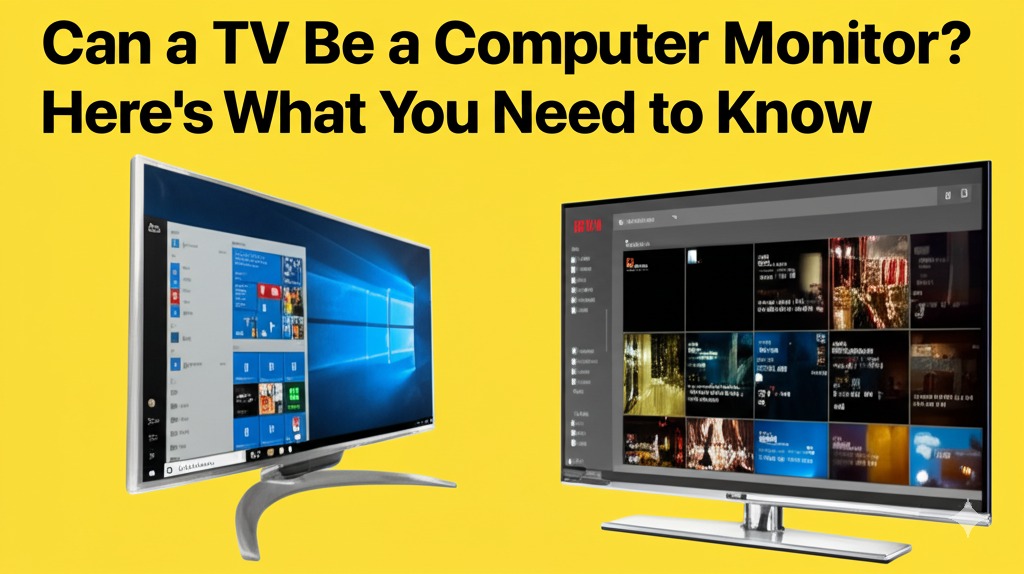In today’s world of remote work, gaming setups, and budget-conscious tech upgrades, many people find themselves asking: Can a TV be used as a computer monitor? The short answer is yes—but there’s a lot more to the story.
Whether you’re trying to repurpose an old TV or just want a bigger display, using a TV as a monitor can be a smart, cost-effective move. But it depends on what you’re using it for, the specs of your devices, and a few technical details. Let’s break it down.
Why Use a TV as a Monitor?
Bigger Screen for Less Money
Televisions often provide more screen real estate than traditional monitors at a similar price point. If you’re looking for an immersive experience—whether for movies, casual browsing, or gaming—a TV might be a solid choice.
Convenience and Versatility
You may already have a TV lying around, so hooking it up to a laptop or desktop could save you from buying another display. Plus, modern smart TVs offer extra features like streaming apps, Bluetooth, and wireless display options.
Key Considerations Before Using a TV as a Monitor
1. Resolution and Screen Size
TVs come in larger sizes, which is great—but only if they have the right resolution. A 55-inch screen with only 1080p resolution might look pixelated up close.
- For best results, use a 4K TV (3840×2160 resolution), especially if you’re sitting close to the screen.
- Ideal screen size for desktop use: 40 to 50 inches, depending on your desk setup and viewing distance.
2. Input Lag and Refresh Rate
Input lag is the delay between your computer sending a signal and the TV displaying it. While not an issue for watching videos, it’s crucial for:
- Gaming
- Video editing
- Graphic design
Look for TVs with a low input lag (under 20ms) and a refresh rate of at least 60Hz. Gaming TVs often include Game Mode, which reduces latency.
3. Connectivity Options
Your computer and TV must speak the same “language.” Most modern setups use HDMI, but check compatibility.
- HDMI: The standard for most TVs and modern computers.
- DisplayPort to HDMI adapters: Useful if your computer doesn’t have an HDMI output.
- DVI/VGA: Older TVs might support these, but the quality may be lower.
Don’t forget about audio—HDMI can carry sound, but you might need external speakers or headphones depending on your needs.
How to Set Up a TV as a Monitor
Setting up is usually straightforward, but here’s a step-by-step guide:
Step 1: Connect the TV
Use an HDMI cable to connect the TV to your PC or laptop. Make sure you plug into the correct HDMI port on your TV.
Step 2: Adjust Display Settings
On your computer:
- Go to Display Settings (Windows) or System Preferences > Displays (Mac).
- Choose to either mirror your display or extend your desktop.
- Set the resolution to match the TV’s native resolution—ideally 1080p or 4K.
Step 3: Enable Game Mode or PC Mode
Many TVs include a “PC” or “Game” mode that optimizes input lag and sharpens the text display. Enable this through your TV’s settings menu.
Step 4: Tweak Text Scaling (Optional)
If your TV screen is too large or too high-resolution, text might appear tiny. Adjust scaling in display settings (e.g., 125% or 150%) for more comfortable reading.
Pros and Cons of Using a TV as a Monitor
✅ Pros:
- Larger screen size
- Cost-effective if you already have a TV
- Great for watching videos, light work, and presentations
- Suitable for console and casual PC gaming
❌ Cons:
- Text can look blurry, especially on lower-res TVs
- Higher input lag than dedicated monitors
- Not ideal for fast-paced competitive gaming or detailed editing
- More desk space needed due to size
Best Use Cases for TV as a Monitor
Using a TV as your primary monitor isn’t for everyone. Here’s where it makes the most sense:
- Media consumption (Netflix, YouTube, etc.)
- Light productivity work (email, browsing, documents)
- Casual gaming
- Home theater PC (HTPC) setups
If you’re a professional designer, video editor, or hardcore gamer, a dedicated high-end monitor may be worth the investment.
Tips for a Better TV-as-Monitor Experience
- Sit farther back to reduce eye strain and get better clarity.
- Use a wireless keyboard and mouse for comfort.
- Enable blue light filters or use night mode for long hours.
- Adjust the sharpness and picture settings on the TV to reduce blurriness.
Final Thoughts: Should You Use a TV as a Monitor?
So, can a TV be a computer monitor? Absolutely. But whether it’s the right choice depends on how you plan to use it.
If you’re a casual user or on a budget, a TV can deliver a surprisingly good experience. Just make sure to check the specs, sit at a reasonable distance, and fine-tune the settings for optimal performance.

Caleb Carlson is a contributing writer at Computer Site Engineering, specializing in computer technology, software trends, and hardware innovations. His articles simplify complex tech topics, making them accessible to readers of all levels.





